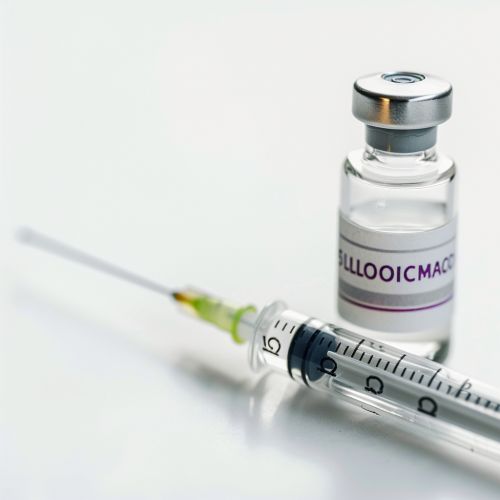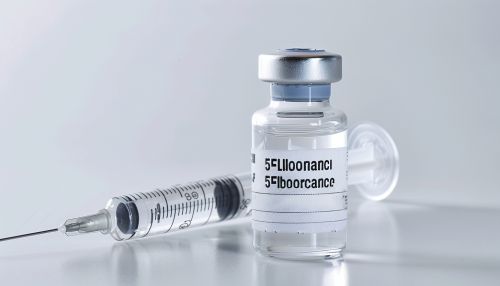5-fluorouracil
Introduction
5-Fluorouracil (5-FU) is a pyrimidine analog and a widely used chemotherapeutic agent. It is primarily employed in the treatment of various cancers, including colorectal, breast, stomach, and pancreatic cancers. As an antimetabolite, 5-FU interferes with the synthesis of DNA and RNA by inhibiting the enzyme thymidylate synthase, which is crucial for DNA replication and repair. This article delves into the pharmacology, mechanism of action, clinical applications, side effects, and resistance mechanisms associated with 5-FU.
Pharmacology
Chemical Structure and Properties
5-Fluorouracil is a fluorinated analog of the nucleobase uracil. Its chemical formula is C4H3FN2O2, and it has a molecular weight of 130.08 g/mol. The presence of a fluorine atom at the C-5 position of the uracil ring is critical for its antineoplastic activity.
Pharmacokinetics
5-FU is administered via various routes, including intravenous, oral, and topical. Upon administration, it undergoes extensive metabolism primarily in the liver by the enzyme dihydropyrimidine dehydrogenase (DPD). The drug's half-life is relatively short, necessitating continuous infusion or frequent dosing to maintain therapeutic levels. The metabolites of 5-FU are excreted through the kidneys.
Mechanism of Action
5-FU exerts its cytotoxic effects through multiple mechanisms:
- **Inhibition of Thymidylate Synthase**: 5-FU is converted intracellularly to 5-fluoro-2'-deoxyuridine monophosphate (FdUMP), which forms a ternary complex with thymidylate synthase and 5,10-methylenetetrahydrofolate. This complex inhibits thymidylate synthase, leading to a depletion of thymidine triphosphate (dTTP), an essential precursor for DNA synthesis.
- **Incorporation into RNA and DNA**: 5-FU is also metabolized to 5-fluorouridine triphosphate (FUTP) and 5-fluoro-2'-deoxyuridine triphosphate (FdUTP), which can be incorporated into RNA and DNA, respectively. The incorporation of these analogs disrupts RNA processing and function, as well as DNA replication and repair.
Clinical Applications
5-FU is a cornerstone in the treatment of various malignancies. Its clinical applications include:
Colorectal Cancer
5-FU is a key component of several chemotherapy regimens for colorectal cancer, such as FOLFOX (5-FU, leucovorin, and oxaliplatin) and FOLFIRI (5-FU, leucovorin, and irinotecan). It is used in both adjuvant and metastatic settings.
Breast Cancer
In breast cancer, 5-FU is often included in combination therapies like CMF (cyclophosphamide, methotrexate, and 5-FU) and CAF (cyclophosphamide, doxorubicin, and 5-FU).
Gastric and Pancreatic Cancers
5-FU is utilized in the treatment of gastric and pancreatic cancers, frequently in combination with other agents such as cisplatin and gemcitabine.
Topical Applications
Topically, 5-FU is used to treat actinic keratosis and superficial basal cell carcinoma. It is formulated as a cream or solution for direct application to the skin lesions.


Side Effects
The administration of 5-FU is associated with a range of side effects, which can be acute or chronic:
Acute Toxicities
- **Gastrointestinal Toxicity**: Nausea, vomiting, diarrhea, and mucositis are common acute toxicities. Severe diarrhea can lead to dehydration and electrolyte imbalances.
- **Myelosuppression**: 5-FU can cause bone marrow suppression, leading to leukopenia, thrombocytopenia, and anemia.
- **Dermatologic Reactions**: Hand-foot syndrome (palmar-plantar erythrodysesthesia) is characterized by redness, swelling, and pain on the palms and soles.
Chronic Toxicities
- **Cardiotoxicity**: 5-FU can cause myocardial ischemia, arrhythmias, and other cardiac events, particularly in patients with pre-existing heart conditions.
- **Neurotoxicity**: Neurotoxic effects include cerebellar ataxia, confusion, and encephalopathy.
Resistance Mechanisms
Resistance to 5-FU can develop through various mechanisms:
- **Upregulation of Thymidylate Synthase**: Increased expression of thymidylate synthase can overcome the inhibitory effects of 5-FU.
- **Alterations in Drug Metabolism**: Mutations or polymorphisms in enzymes involved in 5-FU metabolism, such as DPD, can affect drug efficacy and toxicity.
- **Enhanced DNA Repair**: Increased activity of DNA repair pathways can mitigate the DNA damage induced by 5-FU.
